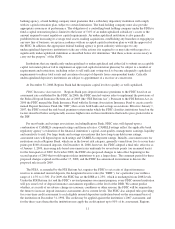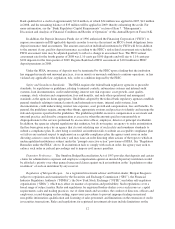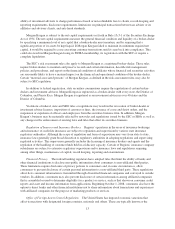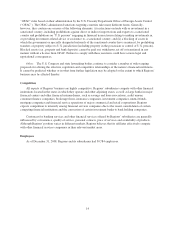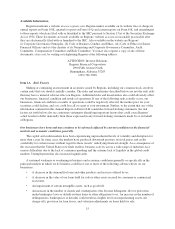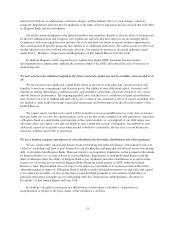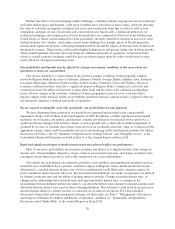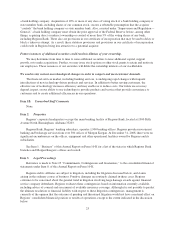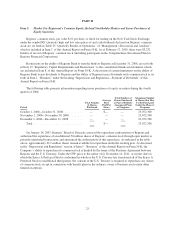Regions Bank 2008 Annual Report Download - page 27
Download and view the complete annual report
Please find page 27 of the 2008 Regions Bank annual report below. You can navigate through the pages in the report by either clicking on the pages listed below, or by using the keyword search tool below to find specific information within the annual report.financial markets and going concern threats to investment banks and other financial institutions. The U.S.
Treasury and federal banking regulators are implementing a number of programs under this legislation and
otherwise to address capital and liquidity issues in the banking system, including the CPP, in which Regions
participated. In addition, other regulators have taken steps to attempt to stabilize and add liquidity to the financial
markets, such as the FDIC’s TLGP.
On February 10, 2009, Treasury Secretary Timothy Geithner announced the Financial Stability Plan, which
earmarks the second $350 billion originally authorized under the EESA. The Financial Stability Plan is intended
to, among other things, make capital available to financial institutions, purchase certain legacy loans and assets
from financial institutions, restart securitization markets for loans to consumers and businesses and relieve
certain pressures on the housing market, including the reduction of mortgage payments and interest rates.
In addition, the American Recovery and Reinvestment Act of 2009 (the “ARRA”), which was signed into
law on February 17, 2009, includes, among other things, extensive new restrictions on the compensation
arrangements of financial institutions participating in TARP.
There can be no assurance, however, as to the actual impact that the EESA, as supplemented by the
Financial Stability Plan, the ARRA and other programs will have on the financial markets, including the extreme
levels of volatility and limited credit availability currently being experienced. The failure of the EESA, the
ARRA, the Financial Stability Plan and other programs to stabilize the financial markets and a continuation or
worsening of current financial market conditions could materially and adversely affect our businesses, financial
condition, results of operations, access to credit or the trading price of our common stock.
The EESA, ARRA and the Financial Stability Plan are relatively new initiatives and, as such, are subject to
change and evolving interpretation. There can be no assurances as to the effects that any further changes will
have on the effectiveness of the government’s efforts to stabalize the credit markets or on our businesses,
financial condition or results of operations.
The limitations on incentive compensation contained in the ARRA may adversely affect Regions’ ability to
retain its highest performing employees.
In the case of a company such as Regions that received CPP funds, the ARRA contains restrictions on bonus
and other incentive compensation payable to the five executives named in a company’s proxy statement and the
next twenty highest paid employees. Depending upon the limitations placed on incentive compensation by the
final regulations issued under the ARRA, it is possible that Regions may be unable to create a compensation
structure that permits Regions to retain its highest performing employees. If this were to occur, Regions’
businesses and results of operations could be adversely affected, perhaps materially.
We are subject to extensive governmental regulation, which could have an adverse impact on our operations.
The banking industry is extensively regulated and supervised under both federal and state law. We are
subject to the regulation and supervision of the Federal Reserve, the FDIC and the Superintendent of Banking of
the State of Alabama. These regulations are intended primarily to protect depositors, the public and the FDIC
insurance fund, and not our shareholders. These regulations govern matters ranging from the regulation of certain
debt obligations, changes in the control of bank holding companies and state-chartered banks, and the
maintenance of adequate capital to the general business operations and financial condition of Regions Bank,
including permissible types, amounts and terms of loans and investments, to the amount of reserves against
deposits, restrictions on dividends, establishment of branch offices, and the maximum interest rate that may be
charged by law. Additionally, certain subsidiaries of Regions and Regions Bank, such as Morgan Keegan, are
subject to regulation, supervision and examination by other regulatory authorities, such as the SEC, FINRA and
state securities and insurance regulators. We are subject to changes in federal and state law, as well as regulations
and governmental policies, income tax laws and accounting principles. Regulations affecting banks and other
17






